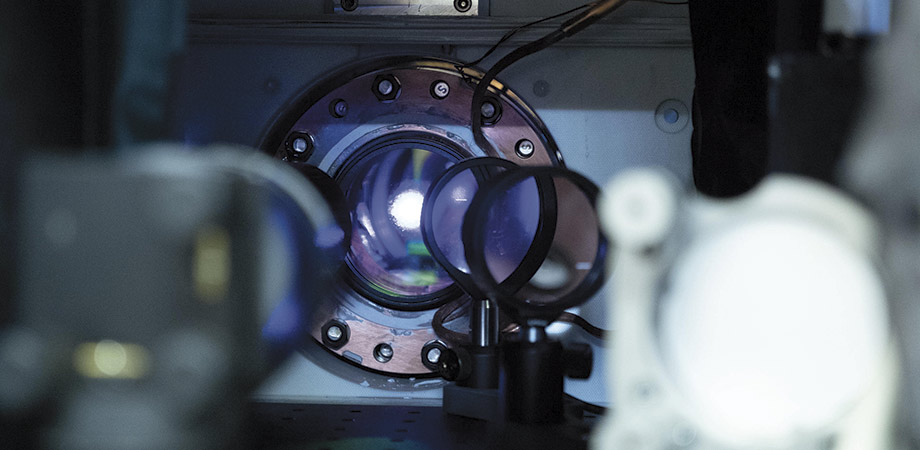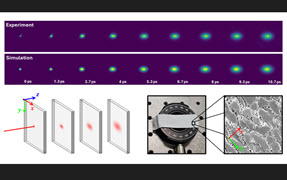Quantum clocks: Ticking away toward a new era of precision measurement

In July 2020, Hidetoshi Katori from the University of Tokyo performed an experiment that shone a spotlight on the astounding accuracy of today’s atomic clocks and their remarkable potential outside of the lab. He and colleagues took a pair of portable, state-of-the-art strontium optical lattice clocks to the Tokyo Skytree broadcasting tower, placing one some 450 m up on an observation deck, while leaving the other down at the base.
They then connected the two clocks with a fiber link so they could see if they would tick at different rates, an observation that would align with Albert Einstein’s theory of general relativity. Because such a test would normally be performed in space, the Tokyo experiment also showed how atomic clocks might be downsized to more application-friendly packages. Success ensued. Six months later, Katori’s team verified that the clock placed higher up the tower was ticking faster by four nanoseconds per day, in accordance with Einstein’s theory.
Einstein’s theory of general relativity predicts that clocks in a deep gravitational field will tick slower than those in a shallower field, an effect known as gravitational redshift. Past tests of the famous physicist’s prediction had taken place using atomic clock-equipped satellites and rockets, thousands of miles apart in space. But with their newer optical atomic clocks, Katori—who also works at the Quantum Metrology Laboratory at RIKEN—and his colleagues had detected changes in time due to gravity at mere meters.
This was a big deal. Katori’s team had tested general relativity with a degree of precision competitive with expensive space-based experiments. Also, the researchers had opened the door to a raft of new applications: more easily probing the fundamental laws of physics with new levels of scrutiny; performing new forms of metrology, such as measuring
geodynamic signals from earthquakes and volcanoes; and improving global navigation satellite systems.
The Tokyo experiment was robust, too. “Three subways were running nearby, and at night-time, the temperature change was almost 10 degrees Celsius,” Katori says. “But our clock apparatus was very robust to vibrations. We’d also installed Doppler noise-canceled telecom fibers to deal with these and used water cooling in our apparatus to stabilize the temperature.”
Prior to the Tokyo Skytree demonstration, Katori’s clock system had occupied his entire 40-square-meter laboratory. But now, the team was able to pack each clock into three much-more-transportable 19-inch rack-mountable boxes. “While we’d made our apparatus much more compact, we’d kept the [performance] similar to our laboratory system,” Katori says.
The researchers’ remarkable results were all down to the atomic clocks’ unprecedented and unwavering accuracy, which had taken decades to reach. Atomic clocks measure time using the resonant frequencies of atoms, which act as the beats, or ticks, of the clock. Conventional atomic clocks are based on clusters of cesium atoms—shine laser light on these atoms and they emit light that oscillates 9.2 billion times every second. However, over the years, various laboratories have been working on optical atomic clocks based on different elements, like strontium and ytterbium, that can emit light at higher frequencies and therefore tick even more precisely.
The first strontium optical lattice clocks emerged some 20 years ago from Katori’s lab, as well as from the laboratory of Jun Ye at JILA in the United States. These atomic clocks are known as quantum clocks because they measure quantum fluctuations—very narrow energy transitions—within strontium atoms. In a typical setup, thousands of ultracold strontium atoms are held almost perfectly still in unison, in a lattice of intense laser light, inside an ultrahigh vacuum chamber. The atoms are then excited with a laser to emit near-infrared light that oscillates at 429,500 GHz—in effect, “ticking” at a rate of nearly 430 trillion times per second, way faster than the rate of cesium atoms.
Since quantum clocks were first developed, researchers have honed their lasers, designed more sophisticated lattices, and upped the numbers of atoms held in optical traps, raising performance. Many of today’s quantum optical lattice clocks can now operate at an uncertainty level of at least 10–18—a real milestone for atomic timekeeping. This level of accuracy means that the clocks will only gain or lose one second every 30 billion years, a period greater than the age of the universe. By contrast, the world-standard cesium atomic clock, which resides at the US National Institute of Standards and Technology (NIST), measures time with an uncertainty level of 10–16, and so deviates by one second every 300 million years.
The incredible potential of smaller, portable, and robust quantum optical clocks has sparked intense international activity. Yogeshwar Kale, for example, is from the University of Birmingham, UK, where he, research lead Yeshpan Singh, and colleagues, have taken quantum-clock miniaturization to the extreme. The team’s compact system includes a less-than-four-liter, ultrahigh vacuum chamber, thought to be smaller than any other chamber used in the field of quantum timekeeping. With the necessary lasers, magnetic field coils, and optics to cool and trap the atoms, they can pack all of it into a 121-liter box. The package weighs less than 75 kg and demands just 320 W of power to operate the clock.

Yogeshwar Kale and colleagues packed their strontium-based quantum clock package into a van and drove it around England to test its robustness. Photo credit: Yogeshwar Kale
According to Kale, other transportable clock setups weigh at least twice as much. “[Other] systems are bulky and consume relatively large amounts of power for use in the field. Atomic clocks in national metrological laboratories are many thousands of liters in size, but right now ours is here, just a box, sitting on a lab bench.”
While the Birmingham package shows remarkable promise for getting optical clocks out of the lab and into the real world, Kale and colleagues have traded portability for precision. The uncertainty of their current set-up comes in at 10–17, an order of magnitude lower than the 10–18 accuracy reached by larger systems. However, Kale is certain their set-up will reach 10–18 soon, with more stable lasers and oscillators.
Already, Kale and colleagues are collaborating with aerospace firm BAE Systems and radar developer Aveillant, on so-called quantum-enabled distributed radar. For this application, their quantum strontium optical atomic clocks will replace existing oscillator technology in a radar system, providing the high precision needed to detect small, slow-moving objects like drones for longer distances and in more cluttered environments.
“Radar phase noise can be considerably reduced when optical clocks are used [instead of traditional oscillators], and this means we’ll be able to use radar to detect much smaller, slow, low-lying objects like drones,” Kale says. “The stability and precision of strontium optical clocks make them crucial to the future,” he adds. “And once we have a compact, robust system that is ready to use outside the laboratory, it will be so useful to mankind.”
Katori agrees: “I wish to see optical lattice clocks used for purposes that can help people.” Since his team showed that the performance of their portable strontium optical lattice clocks matched that of their lab-based systems, he and colleagues have been developing even smaller systems and exploring applications that involve a network of many clocks.
Clocks with the all-important 10–18 uncertainty can measure the difference in height between arbitrary points on Earth at an accuracy of one centimeter. This means a network of these devices might detect small movements of the Earth’s surface such as crustal deformation before an earthquake or the ground swelling of an active volcano.
“We could use these optical lattice clocks to measure dynamic changes in our unstable continent,” says Katori. “For example, when magma rises in a volcano, the mountainside lifts by a few centimeters in a few hours. By comparing two distant optical clocks, we could detect such a height gain.”
To this end, Katori and colleagues collaborate with partners—including Japan-based scientific instrument manufacturers, JEOL and Shimadzu, and Nippon Telegraph and Telephone Corporation (NTT)—to develop a “space-time information platform.” This will be a network of optical lattice clocks connected via phase-stabilized fiber to monitor the Earth’s surface. The group has already implemented a 240-km-long fiber link between Riken, NTT, and the University of Tokyo.
Beyond Earth surface monitoring, this network of quantum clocks will also provide an alternative to GNSS. Many of today’s satellite communications systems rely on atomic clocks to provide the timing precision demanded for measurements, but Katori and colleagues are confident their space-time information platform will take precision levels further.
In 2020, the UK government laid out plans to invest $40 million to build a National Timing Centre under the auspices of the National Physical Laboratory (NPL). This geographically distributed center will be a network of atomic clocks designed to protect national infrastructure and the economy from potential satellite systems failure.
As Helen Margolis, NPL’s Head of Science for Time and Frequency, warns, “Many countries are dangerously reliant on GPS and other global navigation satellite systems. GNSS signals are weak and vulnerable to disruption from jamming, spoofing, or even solar storms.”
The NPL researchers are building the network across four secure sites so if one site goes down, communications can be preserved via the remaining locations. In coming years, the secure system could grow further, making portable atomic clocks all the more important.
“The consequences to the economy of losing GPS, even for a few days, would be dramatic,” says Margolis. “So, we could gradually extend [the network] out across the rest of the UK to more critical infrastructure, as well as industrial and academic users.”
NPL and many other atomic clock players are also in the process of redefining the second. The cesium atomic clock was used to redefine the second in 1967, but with today’s cesium standards reaching an uncertainty of “only” 10–16, it’s perhaps time to move on. The strontium optical lattice clock is one option for use in redefining the second, as are the ytterbium optical lattice and aluminum ion clocks under development at NIST and other laboratories around the world.
A final decision isn’t due until 2030, but trials are well underway. In 2021, the Boulder Atomic Clock Optical Network (BACON), including optical lattice clock inventor Jun Ye and colleague Andrew Ludlow, compared the strontium, ytterbium, and aluminum ion clocks over a period of several months. Each reached the 10–18 target. The experiment has since been followed up by a pan-European group, using 11 different clocks. Results are yet to be published but Margolis says, “We need to make these international comparisons between clocks that have been developed independently.”

Concept image of an optical lattice clock network in Japan. Photo credit: Tomoya Akatsuka, Nippon Telegraph and Telephone Corporation
As the atomic clock ticks ever-more accurately, quantum physicists are becoming more determined to test the limits of fundamental science and probe new physics like that of dark matter, a mysterious substance not yet detected but believed to account for most of the matter in the universe. Indeed, in their 2021 trial, the BACON researchers also searched for signs of possible interaction between atoms and dark matter.
“We already know that our theory of gravity is not consistent with quantum mechanics and the standard model of physics. The feeling is that something, somewhere, is unexplained,” says Margolis. “As [atomic clock] measurements get more sensitive, then maybe probing those theories will help to give us clues on how we might unify those theories.”
Researchers are getting closer. Last year, two teams of researchers—Shimon Kolkowitz and colleagues at the University of Wisconsin, Madison, and Jun Ye and colleagues—each demonstrated exquisite feats of engineering when they pushed the limits of clock precision beyond 10–18 with their strontium optical lattice clocks. Ye’s clock had the edge, demonstrating 10–21 uncertainty, or millimeter-level precision, showing it was possible to measure gravitational redshift on the millimeter scale.
While such remarkably precise systems are not going to break records on package-size yet, epic science will follow. As Kolkowitz said at the time, “Imagine a cloud of dark matter passes through a network of clocks. Are there ways that I can see that dark matter? That’s an experiment we can do now that you just couldn’t do in any previous experimental system.”
Ye is also upbeat. “Our clock precision already opens new opportunities for science but we would like to continue to advance this state-of-the-art so that one day we can achieve clock measurement precision where we can measure time dilation across a single quantum mechanical wave function.”
Time dilation is the slowing of time that could be detected by two atomic clocks at different positions in a gravitational field. If the atomic clocks of tomorrow could detect this phenomenon with the unfathomable precision that Ye is working towards, then physics will surely change forever.
“We want to see how the interplay of quantum physics and gravity come together,” says Ye. “This is not quantum gravity. This is a new paradigm for experimental physics and measurement science.”
Rebecca Pool is a UK-based freelance writer.
| Enjoy this article? Get similar news in your inbox |
|



